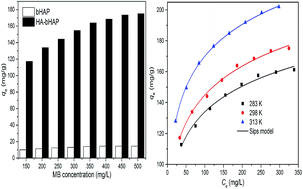Simple combination of humic acid with biogenic hydroxyapatite achieved highly efficient removal of methylene blue from aqueous solution†
Abstract
Biogenic hydroxyapatite (bHAP) derived from eggshell waste impregnated with humic acid (HA) was utilized as an adsorbent to remove methylene blue (MB) from aqueous solution. bHAP simply coupled with HA resulted in highly efficient MB removal due to the introduction of negatively charged groups, which could enhance the adsorption of cationic dyes through electrostatic interactions as confirmed by Fourier transform infrared spectroscopy (FTIR). Adsorption experiment data indicated that MB adsorption by HA-impregnated bHAP (HA-bHAP) obeyed a pseudo-second-order equation, and the adsorption amount of MB increased with both the increases in solution pH and temperature. The adsorption isotherm agreed well with the Sips model, and the maximum adsorption capacity at the given conditions was 393.47 mg g−1. Regeneration studies exhibited that HA-bHAP could be recyclable for a long time. Overall, the results reported herein demonstrated the potential of HA-bHAP for the removal of MB and other cationic dyes from aqueous solution.


 Please wait while we load your content...
Please wait while we load your content...